Influence of Citrus Fruit Waste Filler on the Physical Properties of Silicone-Based Composites
Abstract
:1. Introduction
2. Materials and Methods
2.1. Materials
2.2. Methods
2.2.1. Fillers Characterization
2.2.2. Composite Preparation
2.2.3. Tensile Test
2.2.4. Density Test
2.2.5. Hardness Test
2.2.6. Pin-on-Disc
2.2.7. Abrasion Resistance Tests
3. Results and Discussion
3.1. Fillers Characterization
3.2. SEM Analysis
3.3. Tensile Tests
3.4. Density Test
3.5. Hardness Test
3.6. Pin-on-Disc
3.7. Abrasion Resistance Tests
4. Discussion
5. Conclusions
Author Contributions
Funding
Institutional Review Board Statement
Informed Consent Statement
Data Availability Statement
Acknowledgments
Conflicts of Interest
Appendix A
| Properties | Unit | Value |
|---|---|---|
| Ratio mixing silicone: catalyst | 1: 1 | |
| Pot life | min | 45 |
| Cure time | h | 6 |
| Density | g/cm3 | 1.12 |
| Viscosity | cps | 12,500 |
| Tensile strength | MPa | 2.9 |
| Elongation at break | % | 150–200 |

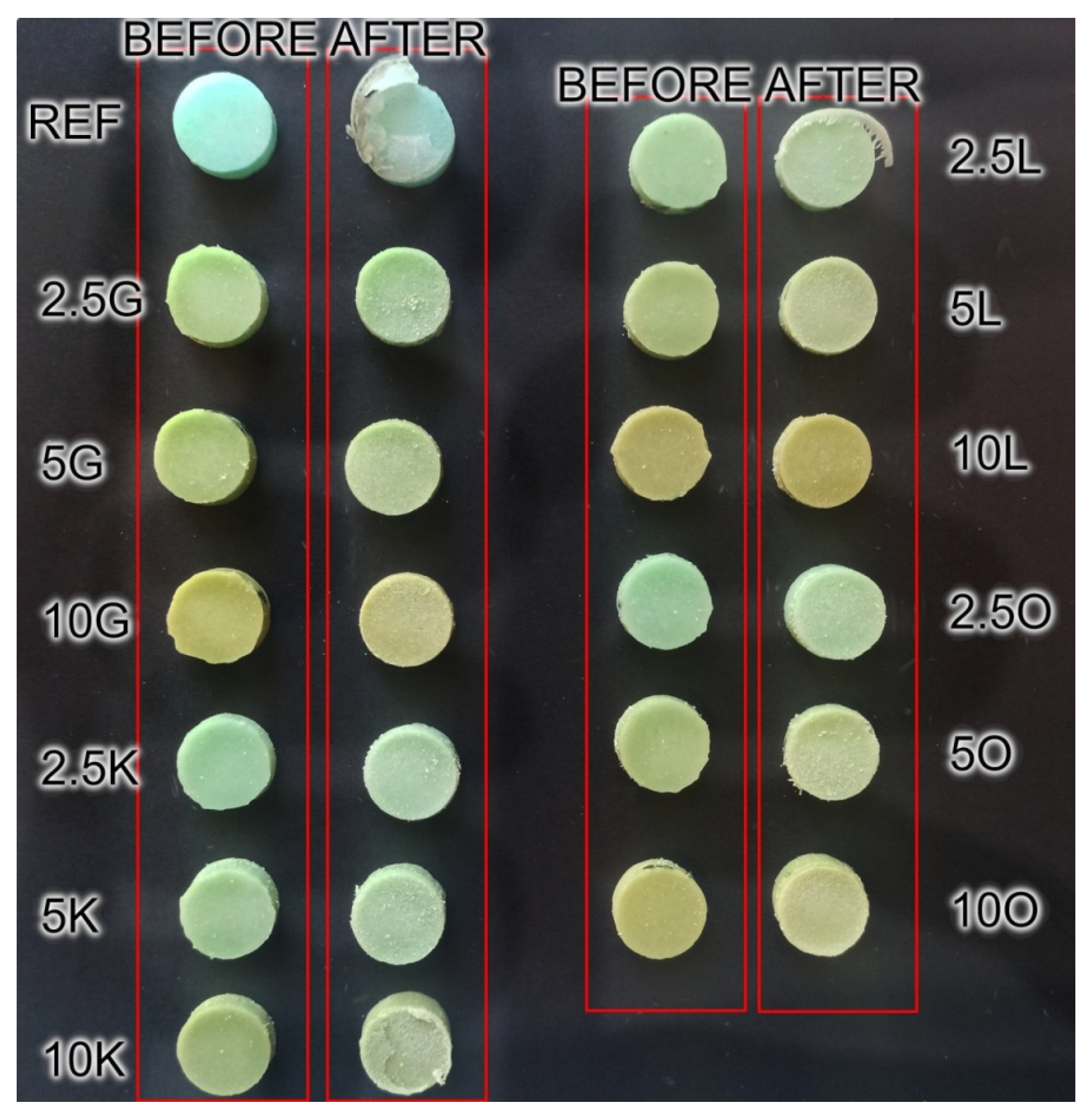
References
- Lenża, J.; Sozańska, M.; Rydarowski, H. Methods for Limiting the Flammability of High-Density Polyethylene with Magnesium Hydroxide. In Reactions and Mechanisms in Thermal Analysis of Advanced Materials, 1st ed.; Tiwari, A., Raj, B., Eds.; Scrivener Publishing LLC: Beverly, MA, USA, 2015; Volume 1, pp. 85–101. [Google Scholar] [CrossRef]
- Kosicka, E.; Krzyzak, A.; Dorobek, M.; Borowiec, M. Prediction of Selected Mechanical Properties of Polymer Composites with Alumina Modifiers. Materials 2022, 15, 882. [Google Scholar] [CrossRef] [PubMed]
- Kosmela, P.; Olszewski, A.; Zedler, Ł.; Burger, P.; Piasecki, A.; Formela, K.; Hejna, A. Ground Tire Rubber Filled Flexible Polyurethane Foam—Effect of Waste Rubber Treatment on Composite Performance. Materials 2021, 14, 3807. [Google Scholar] [CrossRef] [PubMed]
- Kosicka, E.; Borowiec, M.; Kowalczuk, M.; Krzyzak, A.; Szczepaniak, R. Influence of the Selected Physical Modifier on the Dynamical Behavior of the Polymer Composites Used in the Aviation Industry. Materials 2020, 13, 5479. [Google Scholar] [CrossRef] [PubMed]
- Krzyzak, A.; Kosicka, E.; Szczepaniak, R. Research into the Effect of Grain and the Content of Alundum on Tribological Properties and Selected Mechanical Properties of Polymer Composites. Materials 2020, 13, 5735. [Google Scholar] [CrossRef] [PubMed]
- Stabik, J.; Chomiak, M. Graded epoxy-hard coal composites: Analysis of filler particle distribution in the epoxy matrix. J. Compos. Mater. 2016, 50, 3363. [Google Scholar] [CrossRef]
- Jureczko, M.; Mrówka, M. Multiobjective Optimization of Composite Wind Turbine Blade. Materials 2022, 15, 4649. [Google Scholar] [CrossRef] [PubMed]
- Merkel, K.; Lenża, J.; Rydarowski, H.; Pawlak, A.; Wrzalik, R. Characterization of structure and properties of polymer films made from blends of polyethylene with poly(4-methyl-1-pentene). J. Mater. Res. 2017, 32, 451. [Google Scholar] [CrossRef]
- Eckrich, M.; Arrabiyeh, P.A.; Dlugaj, A.M.; May, D. Placement defects in thermoset-impregnated rovings deposited along curved paths. Polym. Compos. 2023, 44, 3634–3645. [Google Scholar] [CrossRef]
- Bazan, P.; Kuciel, S.; Nykiel, M. Characterization of composites based on polyoxymethylene and effect of silicone addition on mechanical and tribological behavior. Polym. Eng. Sci. 2019, 59, 935. [Google Scholar] [CrossRef]
- Kosicka, E.; Gola, A.; Pawlak, J. Application-based support of machine maintenance. IFAC-PapersOnLine 2019, 52, 131–135. [Google Scholar] [CrossRef]
- Krzyzak, A.; Racinowski, D.; Szczepaniak, R.; Mucha, M.; Kosicka, E. The Impact of Selected Atmospheric Conditions on the Process of Abrasive Wear of CFRP. Materials 2020, 13, 3965. [Google Scholar] [CrossRef] [PubMed]
- Szczepaniak, R.; Komorek, A.; Przybyłek, P.; Krzyżak, A.; Roskowicz, M.; Godzimirski, J.; Pinkiewicz, E.; Jaszczak, W.; Kosicka, E. Research into mechanical properties of an ablative composite on a polymer matrix base with aerogel particles. Compos. Struct. 2022, 280, 114855. [Google Scholar] [CrossRef]
- Panasiuk, K.; Dudzik, K. Determining the Stages of Deformation and Destruction of Composite Materials in a Static Tensile Test by Acoustic Emission. Materials 2022, 15, 313. [Google Scholar] [CrossRef] [PubMed]
- Kosicka, E.; Borowiec, M.; Kowalczuk, M.; Krzyzak, A. Dynamic Behavior of Aviation Polymer Composites at Various Weight Fractions of Physical Modifier. Materials 2021, 14, 6897. [Google Scholar] [CrossRef] [PubMed]
- Friedrich, K. Polymer composites for tribological applications. Adv. Ind. Eng. Polym. Res. 2018, 1, 3. [Google Scholar] [CrossRef]
- Mrówka, M.; Jaszcz, K.; Skonieczna, M. Anticancer activity of functional polysuccinates with N-acetyl-cysteine in side-chains. Eur. J. Pharmacol. 2020, 885, 173501. [Google Scholar] [CrossRef] [PubMed]
- Bialas, O.; Lis, M.; Woźniak, A.; Adamiak, M. Laser Superficial Fusion of Gold Nanoparticles with PEEK Polymer for Cardiovascular Application. Materials 2021, 14, 971. [Google Scholar] [CrossRef] [PubMed]
- Niewolik, D.; Bednarczyk-Cwynar, B.; Ruszkowski, P.; Dzido, G.; Jaszcz, K. Highly Branched Betulin Based Polyanhydrides for Self-Assembled Micellar Nanoparticles Formulation. Int. J. Mol. Sci. 2022, 23, 11462. [Google Scholar] [CrossRef]
- Chomiak, M. Reuse of polyester-glass laminate waste in polymer composites. J. Achiev. Mater. Manuf. 2021, 107, 49–58. [Google Scholar] [CrossRef]
- Naik, P.; Acharya, S.K.; Sahoo, P.; Pradhan, S. Abrasive wear behaviour of orange peel (biowaste) particulate reinforced polymer composites. Proc. Inst. Mech. Eng. Part J J. Eng. Tribol. 2021, 235, 2099–2109. [Google Scholar] [CrossRef]
- Kumar, R.S.; Balasundar, P.; Al-Dhabi, N.A.; Prithivirajan, R.; Ramakumar, T.; Bhat, K.S.; Senthil, S.; Narayanasamy, P. A New Natural Cellulosic Pigeon Pea (Cajanus cajan) Pod Fiber Characterization for Bio-degradable Polymeric Composites. J. Nat. Fibers 2021, 18, 1285–1295. [Google Scholar] [CrossRef]
- Hejna, A.; Korol, J.; Kosmela, P.; Kuzmin, A.; Piasecki, A.; Kulawik, A.; Chmielnicki, B. By-Products from Food Industry as a Promising Alternative for the Conventional Fillers for Wood–Polymer Composites. Polymers 2021, 13, 893. [Google Scholar] [CrossRef] [PubMed]
- Sharma, H.; Singh, I.; Misra, J.P. Mechanical and thermal behaviour of food waste (Citrus limetta peel) fillers–based novel epoxy composites. Polym. Polym. Compos. 2019, 27, 527–535. [Google Scholar] [CrossRef]
- Dalbehera, S.; Acharya, S.K. Impact of stacking sequence on tribological wear performance of woven jute-glass hybrid epoxy composites. Tribol.-Mater. Surf. Interfaces 2015, 9, 196–201. [Google Scholar] [CrossRef]
- Omrani, E.; Menezes, P.L.; Rohatgi, P.K. State of the art on tribological behavior of polymer matrix composites reinforced with natural fibers in the green materials world. Eng. Sci. Technol. Int. J. 2016, 19, 717–736. [Google Scholar] [CrossRef]
- Olejnik, O.; Masek, A.; Szynkowska-Jóźwik, M.I. Self-Healable Biocomposites Crosslinked with a Combination of Silica and Quercetin. Materials 2021, 14, 4028. [Google Scholar] [CrossRef] [PubMed]
- Masek, A.; Olejnik, O. Aging Resistance of Biocomposites Crosslinked with Silica and Quercetin. Int. J. Mol. Sci. 2021, 22, 10894. [Google Scholar] [CrossRef]
- Sydow, Z.; Sydow, M.; Wojciechowski, Ł.; Bieńczak, K. Tribological Performance of Composites Reinforced with the Agricultural, Industrial and Post-Consumer Wastes: A Review. Materials 2021, 14, 1863. [Google Scholar] [CrossRef]
- Vitale, M.; Barbero-Barrera, M.d.M.; Cascone, S.M. Thermal, Physical and Mechanical Performance of Orange Peel Boards: A New Recycled Material for Building Application. Sustainability 2021, 13, 7945. [Google Scholar] [CrossRef]
- Tangjuank, S. Thermal insulation and physical properties of particleboards from pineapple leaves. Int. J. Phys. Sci. 2011, 6, 4528–4532. [Google Scholar] [CrossRef]
- Lamrani, M.; Laaroussi, N.; Khabbazi, A.; Khalfaoui, M.; Garoum, M.; Feiz, A. Experimental study of thermal properties of a new ecological building material based on peanut shells and plaster. Case Stud. Constr. Mater. 2017, 7, 294–304. [Google Scholar] [CrossRef]
- Bieliński, D.M.; Anyszka, R.; Masłowski, M.; Pingot, T.; Pędzich, Z. Rheology, extrudability and mechanical properties of ceramizable silicone composites. Kompozyty 2011, 11, 252. [Google Scholar]
- Song, P.; Peng, Z.-J.; Yue, Y.-L.; Zhang, H.; Zhang, Z.; Fan, Y.-C. Mechanical properties of silicone composites reinforced with-micron- and nano-sized magnetic particles. Express Polym. Lett. 2013, 7, 546–553. [Google Scholar] [CrossRef]
- Masłowski, M.; Zaborski, M. Effect of thermooxidative and photooxidative aging processes on mechanical properties of mag-netorheological elastomer composites. Polimery 2015, 60, 264. [Google Scholar] [CrossRef]
- Masłowski, M.; Strąkowska, A.; Pingot, M.; Zaborski, M. Effect of ionic liquids on the selected properties of magnetic composites filled with micro-sized iron oxide (Fe3O4). Polimery 2016, 51, 117. [Google Scholar] [CrossRef]
- Imiela, M.; Anyszka, R.; Bieliński, D.M.; Pędzich, Z.; Zarzecka-Napierała, M.; Szumera, M. Effect of carbon fibers on thermal properties and mechanical strength of ceramizable composites based on silicone rubber. J. Therm. Anal. Calorim. 2016, 124, 197. [Google Scholar] [CrossRef]
- Fan, J.; Wang, Z.; Zhang, X.; Deng, Z.; Fan, X.; Zhang, G. High Moisture Accelerated Mechanical Behavior Degradation of Phosphor/Silicone Composites Used in White Light-Emitting Diodes. Polymers 2019, 11, 1277. [Google Scholar] [CrossRef] [PubMed]
- Jin, H.; Bing, W.; Tian, L.; Wang, P.; Zhao, J. Combined Effects of Color and Elastic Modulus on Antifouling Performance: A Study of Graphene Oxide/Silicone Rubber Composite Membranes. Materials 2019, 12, 2608. [Google Scholar] [CrossRef]
- Beter, J.; Schrittesser, B.; Lechner, B.; Reza Mansouri, M.; Marano, C.; Fuchs, P.F.; Pinter, G.; Beter, J.; Schrittesser, B.; Lechner, B.; et al. Viscoelastic Behavior of Glass-Fiber-Reinforced Silicone Composites Exposed to Cyclic Loading. Polymers 2020, 12, 1862. [Google Scholar] [CrossRef]
- Song, J.; Huang, Z.; Qin, Y.; Wang, H.; Shi, M. Effects of Zirconium Silicide on the Vulcanization, Mechanical and Ablation Resistance Properties of Ceramifiable Silicone Rubber Composites. Polymers 2020, 12, 496. [Google Scholar] [CrossRef]
- Sławski, S.; Woźniak, A.; Bazan, P.; Mrówka, M. The Mechanical and Tribological Properties of Epoxy-Based Composites Filled with Manganese-Containing Waste. Materials 2022, 15, 1579. [Google Scholar] [CrossRef] [PubMed]
- Mrówka, M.; Woźniak, A.; Nowak, J.; Wróbel, G.; Sławski, S. Determination of Mechanical and Tribological Properties of Silicone-Based Composites Filled with Manganese Waste. Materials 2021, 14, 4459. [Google Scholar] [CrossRef] [PubMed]
- EN ISO 527-1:2012; Plastics—Determination of Tensile Properties—Part 1: General Principles. Polish Committee for Standardization: Warsaw, Poland, 2012.
- EN ISO 1183-1:2006; Plastics—Methods for Determining the Density of Non-Cellular Plastics—Part 1: Immersion Method, Liquid Pyknometer Method and Titration Method. Polish Committee for Standardization: Warsaw, Poland, 2006.
- EN ISO 7619-1:2010; Rubber, Vulcanized or Thermoplastic—Determination of Indentation hardness—Part 1: Durometer Method (Shore Hardness). Polish Committee for Standardization: Warsaw, Poland, 2010.
- ASTM A99-03(2019); Standard Specification for Ferromanganese. ASTM International: West Conshohocken, PA, USA, 2019.
- EN ISO 4649:2007; Rubber, Vulcanized or Thermoplastic—Determination of Abrasion Resistance Using a Rotating Cylindrical Drum Device. Polish Committee for Standardization: Warsaw, Poland, 2007.
- Salih, S.I.; Oleiwi, J.K.; Ali, H.M. Modification of Silicone Rubber by Added PMMA and Natural Nanoparticle Used for Maxillofacial Prosthesis Applications. ARPN J. Eng. Appl. Sci. 2019, 14, 11. [Google Scholar]
- Alsaadi, M.; Erkliğ, A.; Albu-khaleefah, K. Effect of Pistachio Shell Particle Content on the Mechanical Properties of Polymer Composite. Arab. J. Sci. Eng. 2018, 43, 4689–4696. [Google Scholar] [CrossRef]
- Nayak, S.; Kini, U.; Heckadka, S. Pistachio shell flakes and flax fibers as reinforcement in polyester-based composite. In Proceedings of the International Conference on Engineering and Information Technology, Kuala Lampur, Malaysia, 17–18 March 2017. [Google Scholar]
- Al-Obaidi, A.; Ahmed, S.J.; Abbas, A. Investigation the mechanical properties of epoxy polymer by adding natural materials. J. Eng. Sci. Technol 2020, 15, 2544–2558. [Google Scholar]
- Zarrinbakhsh, N.; Wang, T.; Rodriguez-Uribe, A.; Misra, M.; Mohanty, A.K. Characterization of wastes and coproducts from the coffee industry for composite material production. BioResources 2016, 11, 7637–7653. [Google Scholar] [CrossRef]
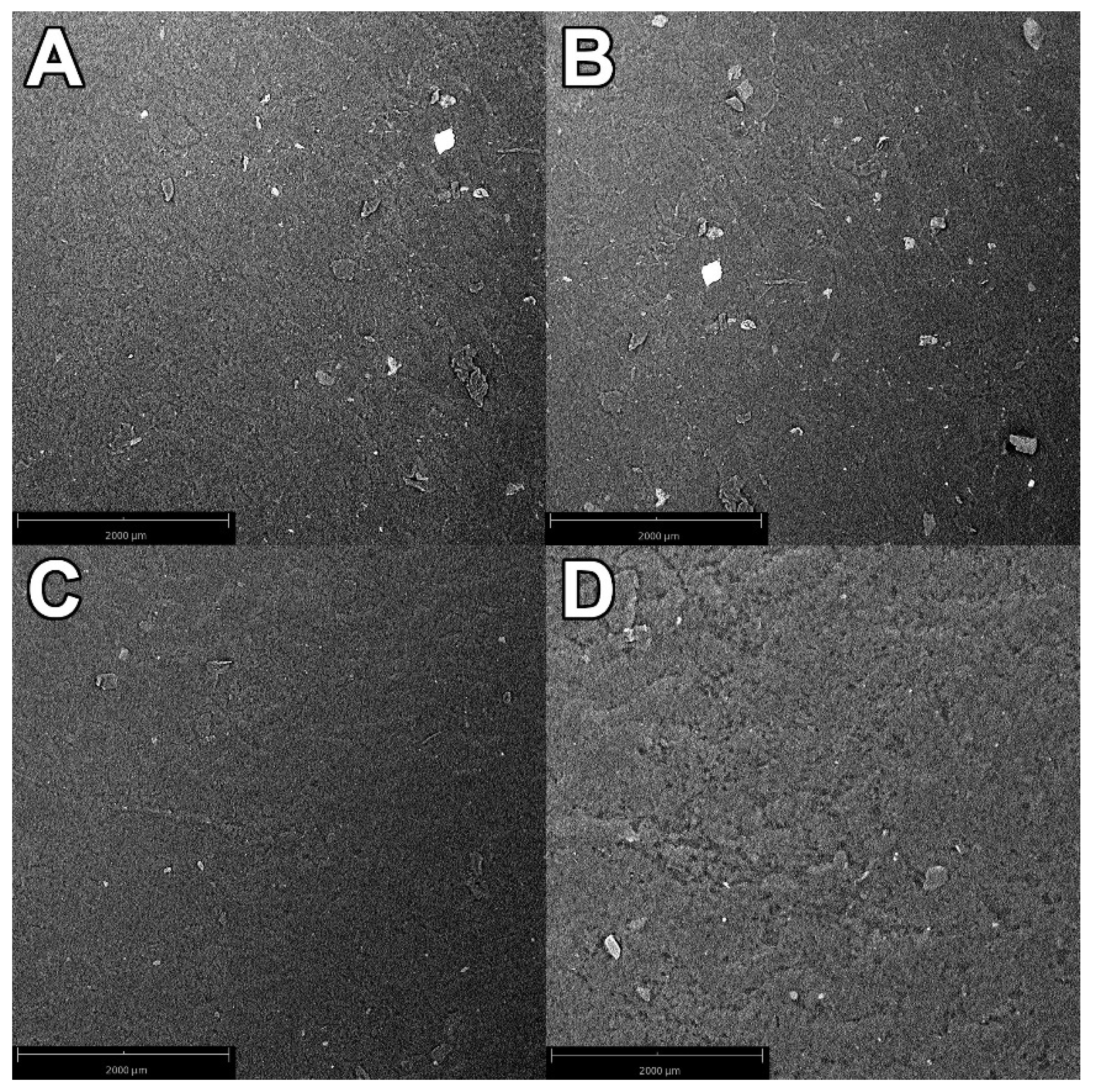

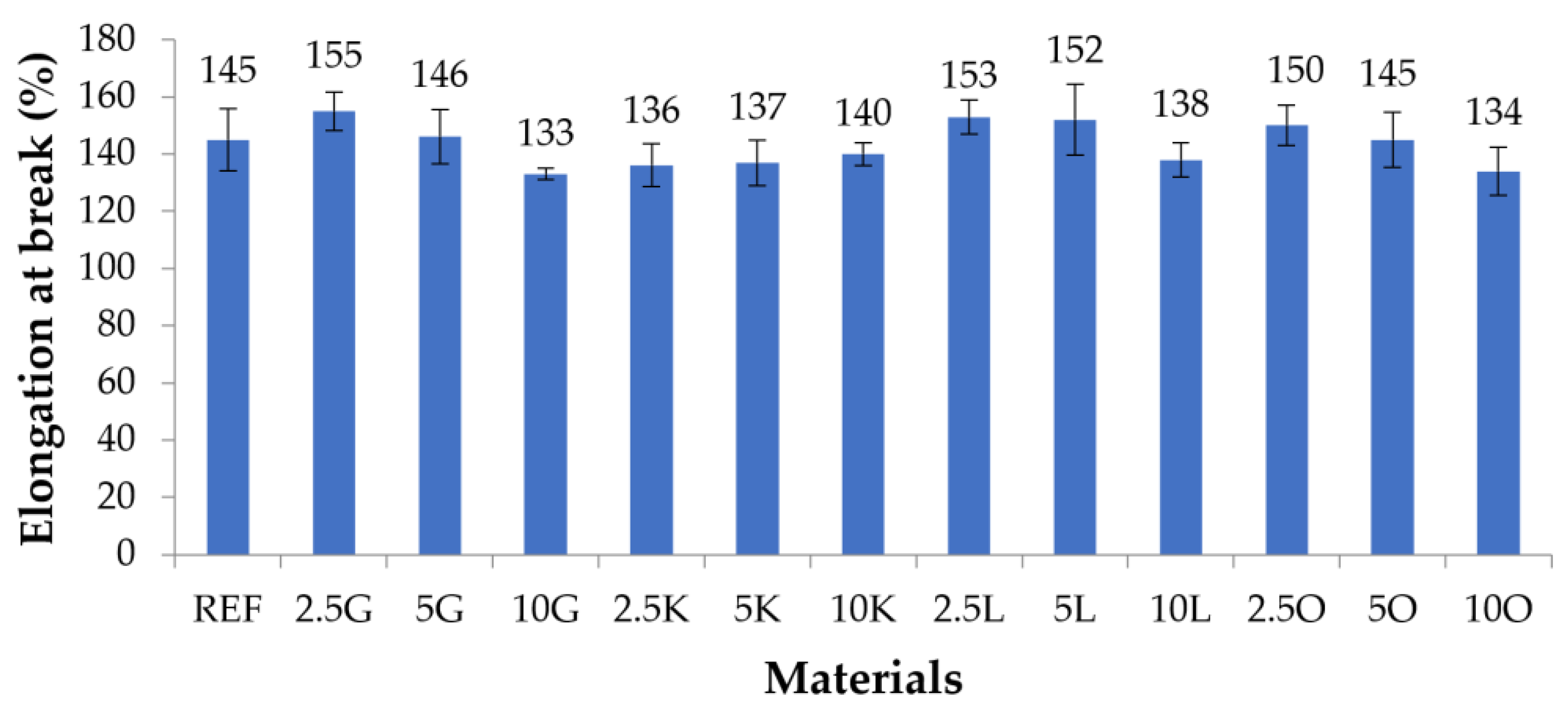
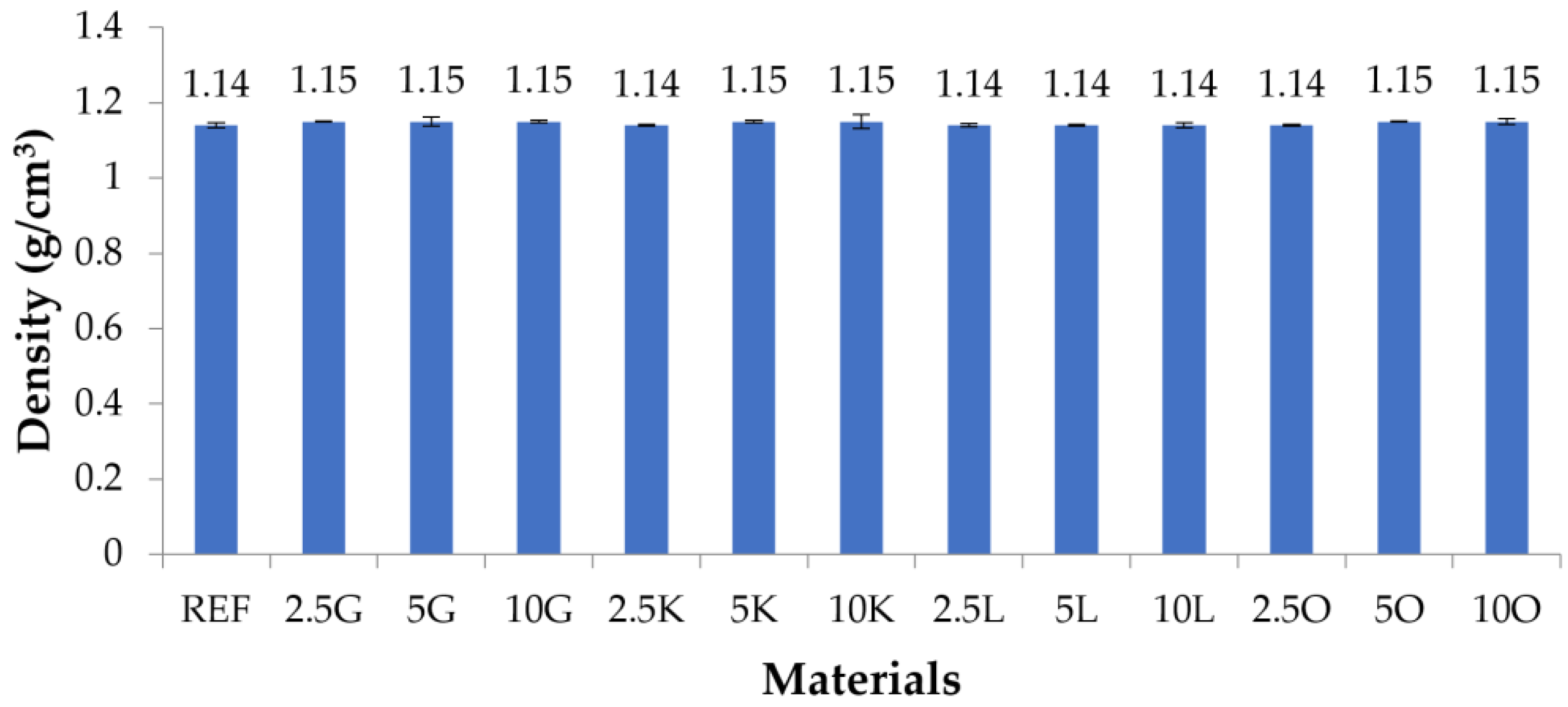
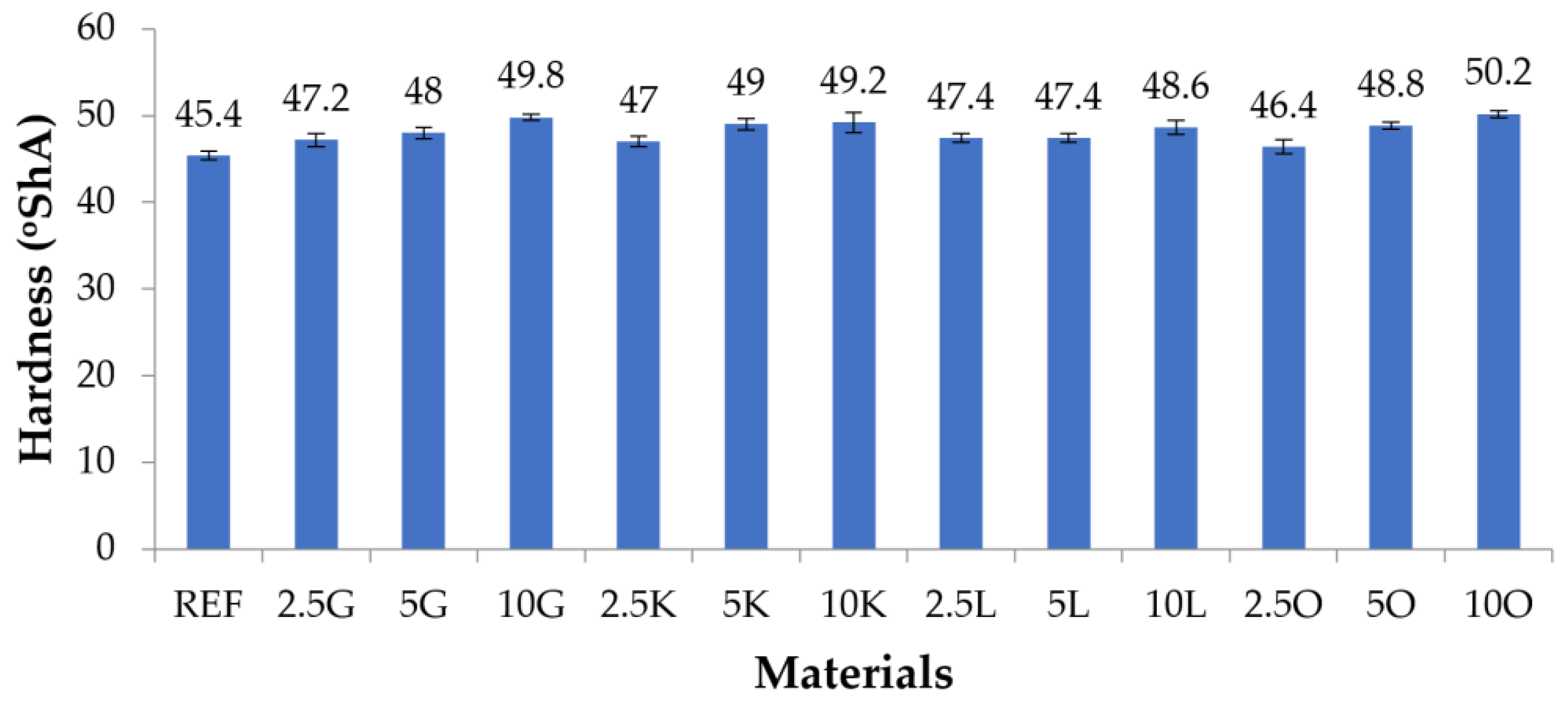
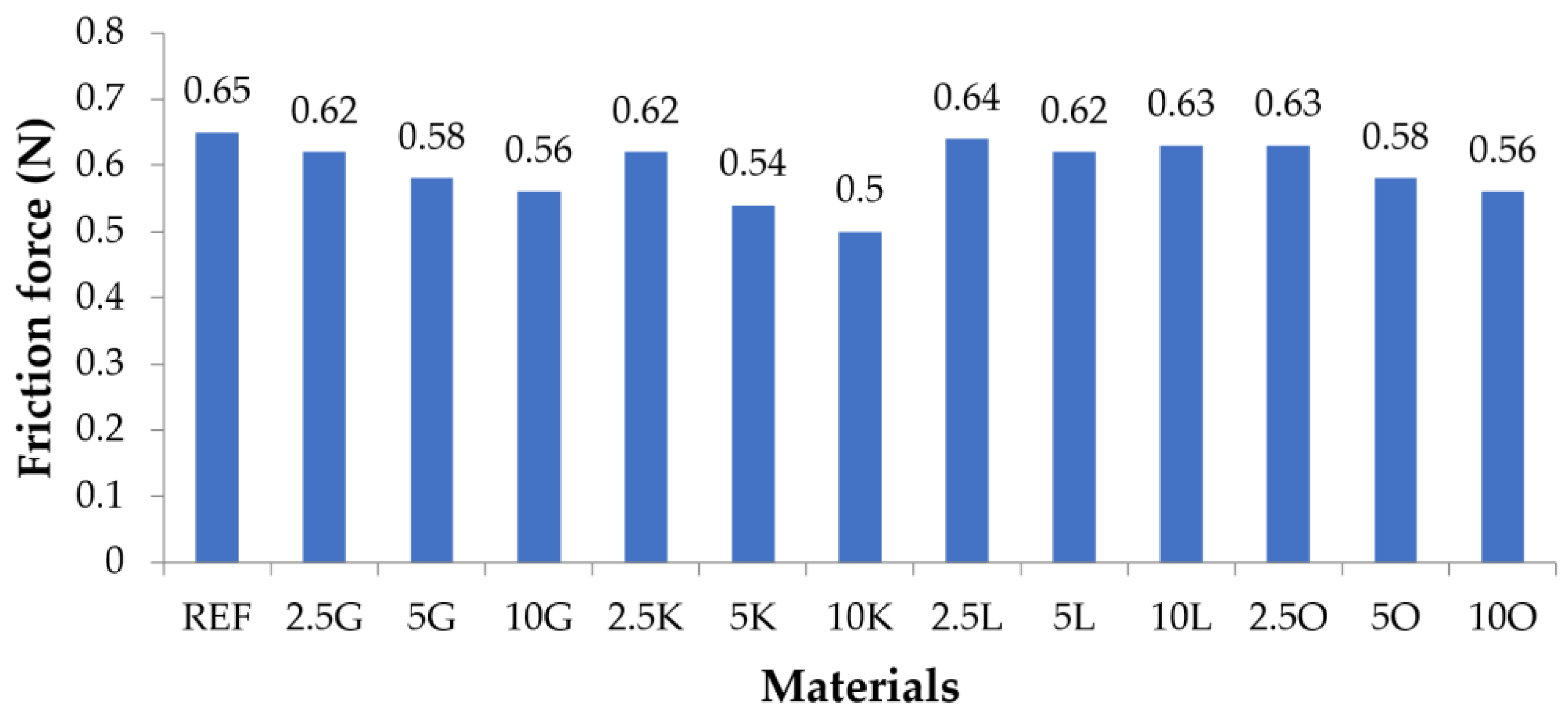
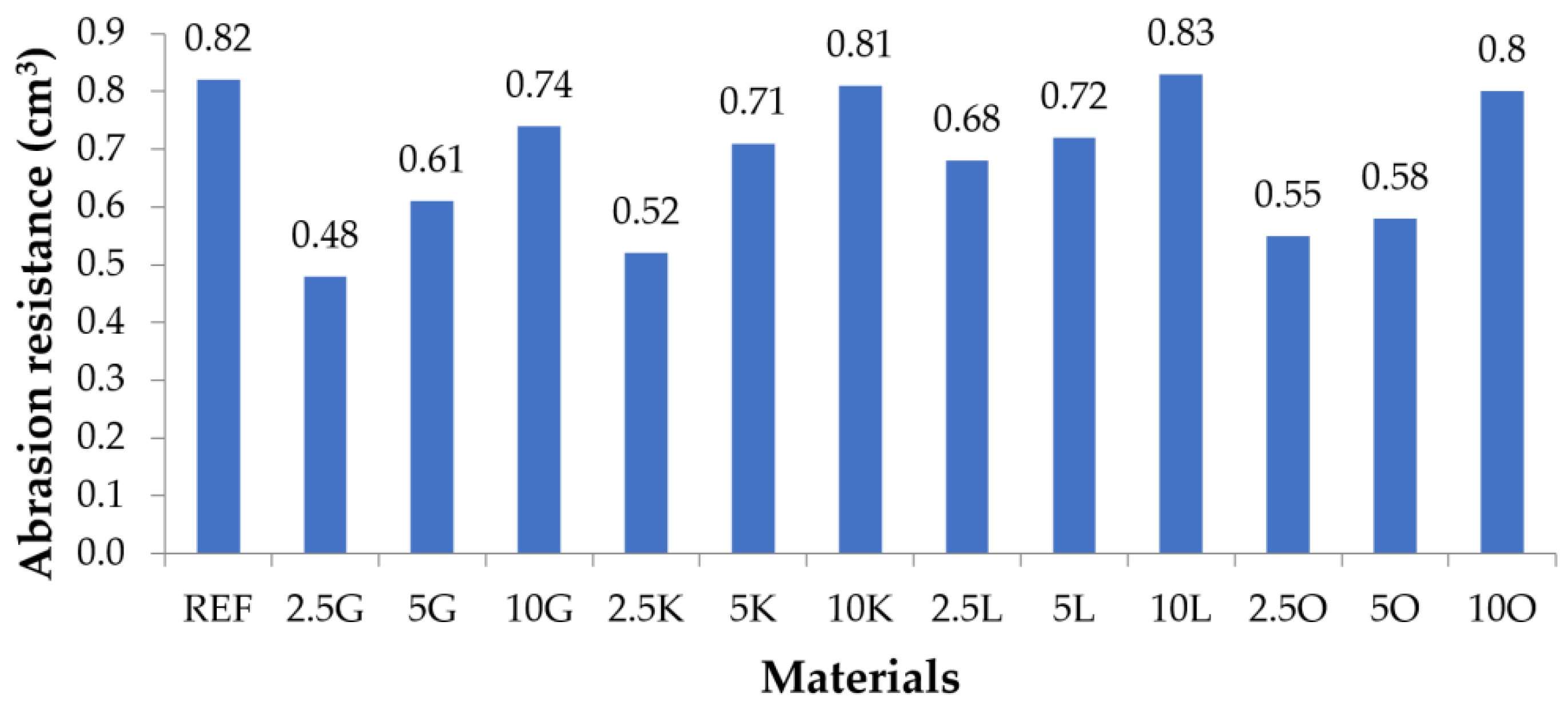
| Sample Name | Silicone | Filler | Filler Content (wt.%) |
|---|---|---|---|
| REF | Mold Star 30 | - | 0 |
| 2.5G | grapefruit | 2.5 | |
| 5G | grapefruit | 5 | |
| 10G | grapefruit | 10 | |
| 2.5K | key lime | 2.5 | |
| 5K | key lime | 5 | |
| 10K | key lime | 10 | |
| 2.5L | lemon | 2.5 | |
| 5L | lemon | 5 | |
| 10L | lemon | 10 | |
| 2.5O | orange | 2.5 | |
| 5O | orange | 5 | |
| 10O | orange | 10 |
| Grainclass (mm) | Yield of Product (%) | |||
|---|---|---|---|---|
| Grapefruit | Key Lime | Lemon | Orange | |
| >0.32 | 4.8 | 3.81 | 0.77 | 0.55 |
| 0.32–0.22 | 2.75 | 1.52 | 1.34 | 0.52 |
| 0.22–0.18 | 45.53 | 11.7 | 50.85 | 4.67 |
| 0.18–0.16 | 19.25 | 5.64 | 14.04 | 10.97 |
| 0.16–0.125 | 20.82 | 11.21 | 25.35 | 26.4 |
| 0.125–0.065 | 5.69 | 36.16 | 3.27 | 32.76 |
| 0.065–0.03 | 0.97 | 20.98 | 3.64 | 18.61 |
| <0.03 | 0.19 | 8.98 | 0.74 | 5.52 |
| Filler | Bulk Density (g/cm3) | Tap Density (g/cm3) |
|---|---|---|
| Grapefruit | 0.42 | 0.69 |
| Key lime | 0.48 | 0.84 |
| Lemon | 0.44 | 0.84 |
| Orange | 0.43 | 0.78 |
| Materials | REF | 2.5G | 5G | 10G | 2.5K | 5K | 10K | 2.5L | 5L | 10L | 2.5O | 5O | 10O |
|---|---|---|---|---|---|---|---|---|---|---|---|---|---|
| Tensile strength (MPa) | 3.08 ± 0.63 | 2.84 ± 0.27 | 2.75 ± 0.46 | 2.23 ± 0.16 | 2.48 ± 0.27 | 2.6 ± 0.41 | 2.11 ± 0.22 | 2.85 ± 0.28 | 2.82 ± 0.44 | 2.27 ± 0.25 | 2.63 ± 0.3 | 2.58 ± 0.46 | 2.13 ± 0.29 |
| Materials | REF | 2.5G | 5G | 10G | 2.5K | 5K | 10K | 2.5L | 5L | 10L | 2.5O | 5O | 10O |
|---|---|---|---|---|---|---|---|---|---|---|---|---|---|
| Elongation at break (%) | 145 ± 22.45 | 155 ± 21.76 | 146 ± 13.37 | 133 ± 19.06 | 136 ± 4.04 | 137 ± 14.99 | 140 ± 15.87 | 153 ± 7.77 | 152 ± 11.75 | 138 ± 24.98 | 150 ± 11.9 | 145 ± 13.89 | 134 ± 19.06 |
| Materials | REF | 2.5G | 5G | 10G | 2.5K | 5K | 10K | 2.5L | 5L | 10L | 2.5O | 5O | 10O |
|---|---|---|---|---|---|---|---|---|---|---|---|---|---|
| Density (g/cm3) | 1.14 ± 0.006 | 1.15 ± 0.001 | 1.15 ± 0.012 | 1.15 ± 0.003 | 1.14 ± 0.002 | 1.15 ± 0.004 | 1.15 ± 0.018 | 1.14 ± 0.005 | 1.14 ± 0.003 | 1.14 ± 0.006 | 1.14 ± 0.003 | 1.15 ± 0.002 | 1.15 ± 0.07 |
| Materials | REF | 2.5G | 5G | 10G | 2.5K | 5K | 10K | 2.5L | 5L | 10L | 2.5O | 5O | 10O |
|---|---|---|---|---|---|---|---|---|---|---|---|---|---|
| Hardness (ShA) | 45.4 ± 0.49 | 47.2 ± 0.75 | 48 ± 0.63 | 49.8 ± 0.4 | 47 ± 0.63 | 49 ± 0.63 | 49.2 ± 1.17 | 47.4 ± 0.49 | 47.4 ± 0.49 | 48.6 ± 0.8 | 46.4 ± 0.8 | 48.8 ± 0.4 | 50.2 ± 0.4 |
| Materials | REF | 2.5G | 5G | 10G | 2.5K | 5K | 10K | 2.5L | 5L | 10L | 2.5O | 5O | 10O |
|---|---|---|---|---|---|---|---|---|---|---|---|---|---|
| Friction force (N) | 0.65 | 0.62 | 0.58 | 0.56 | 0.62 | 0.54 | 0.5 | 0.64 | 0.62 | 0.63 | 0.63 | 0.58 | 0.56 |
| Materials | REF | 2.5G | 5G | 10G | 2.5K | 5K | 10K | 2.5L | 5L | 10L | 2.5O | 5O | 10O |
|---|---|---|---|---|---|---|---|---|---|---|---|---|---|
| Abrasion resistance (cm3) | 0.82 | 0.48 | 0.61 | 0.74 | 0.52 | 0.71 | 0.81 | 0.68 | 0.72 | 0.83 | 0.55 | 0.58 | 0.8 |
Disclaimer/Publisher’s Note: The statements, opinions and data contained in all publications are solely those of the individual author(s) and contributor(s) and not of MDPI and/or the editor(s). MDPI and/or the editor(s) disclaim responsibility for any injury to people or property resulting from any ideas, methods, instructions or products referred to in the content. |
© 2023 by the authors. Licensee MDPI, Basel, Switzerland. This article is an open access article distributed under the terms and conditions of the Creative Commons Attribution (CC BY) license (https://creativecommons.org/licenses/by/4.0/).
Share and Cite
Mrówka, M.; Franke, D.; Ošlejšek, M.; Jureczko, M. Influence of Citrus Fruit Waste Filler on the Physical Properties of Silicone-Based Composites. Materials 2023, 16, 6569. https://doi.org/10.3390/ma16196569
Mrówka M, Franke D, Ošlejšek M, Jureczko M. Influence of Citrus Fruit Waste Filler on the Physical Properties of Silicone-Based Composites. Materials. 2023; 16(19):6569. https://doi.org/10.3390/ma16196569
Chicago/Turabian StyleMrówka, Maciej, Dawid Franke, Martin Ošlejšek, and Mariola Jureczko. 2023. "Influence of Citrus Fruit Waste Filler on the Physical Properties of Silicone-Based Composites" Materials 16, no. 19: 6569. https://doi.org/10.3390/ma16196569
APA StyleMrówka, M., Franke, D., Ošlejšek, M., & Jureczko, M. (2023). Influence of Citrus Fruit Waste Filler on the Physical Properties of Silicone-Based Composites. Materials, 16(19), 6569. https://doi.org/10.3390/ma16196569






